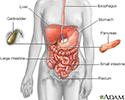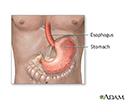Gastritis
Gastritis occurs when the lining of the stomach becomes inflamed or swollen.
Gastritis may last for only a short time (acute gastritis) or it may linger for months to years (chronic gastritis).
Causes
The most common causes of gastritis are:
- Certain medicines, such as aspirin, ibuprofen, or naproxen and other similar drugs
- Heavy alcohol drinking
- Infection of the stomach with a bacteria called Helicobacter pylori
Less common causes are:
- Autoimmune disorders (such as pernicious anemia)
- Backflow of bile into the stomach (bile reflux)
- Cocaine use
- Eating or drinking caustic or corrosive substances (such as poisons)
- Extreme stress
- Viral infection, such as cytomegalovirus and herpes simplex virus (more often occurs in people with a weak immune system)
Trauma or a severe, sudden illness such as major surgery, kidney failure, or being placed on a breathing machine may cause gastritis.
Symptoms
Many people with gastritis do not have any symptoms.
Symptoms you may notice are:
-
Loss of appetite
Loss of appetite
A decreased appetite is when your desire to eat is reduced. The medical term for a loss of appetite is anorexia.
 ImageRead Article Now Book Mark Article
ImageRead Article Now Book Mark Article - Nausea and vomiting
- Pain in the upper part of the belly or abdomen
If gastritis is causing bleeding from the lining of the stomach, symptoms may include:
- Black stools
-
Vomiting blood or coffee-ground-like material
Vomiting blood
Vomiting blood is regurgitating (throwing up) contents of the stomach that contains blood. Vomited blood may appear bright red, dark red, or look lik...
Read Article Now Book Mark Article
Exams and Tests
Tests that may be needed are:
-
Complete blood count (CBC) to check for anemia or low blood count
Complete blood count
A complete blood count (CBC) test measures the following:The number of white blood cells (WBC count)The number of red blood cells (RBC count)The numb...
 ImageRead Article Now Book Mark Article
ImageRead Article Now Book Mark ArticleAnemia
Anemia is a condition in which the body does not have enough healthy red blood cells. Red blood cells provide oxygen to body tissues. Different type...
 ImageRead Article Now Book Mark Article
ImageRead Article Now Book Mark Article - Examination of the stomach with an endoscope (esophagogastroduodenoscopy or EGD) with biopsy of stomach lining
EGD
Esophagogastroduodenoscopy (EGD) is a test to examine the lining of the esophagus, stomach, and first part of the small intestine (the duodenum)....
 ImageRead Article Now Book Mark Article
ImageRead Article Now Book Mark Article - H pylori tests (breath test or stool test)
- Stool test to check for small amounts of blood in the stools, which may be a sign of bleeding in the stomach
Treatment
Treatment depends on what is causing the problem. Some of the causes will go away over time.
You may need to stop taking aspirin, ibuprofen, naproxen, or other medicines that may be causing gastritis. Always talk to your health care provider before stopping any medicine.
You may use other over-the-counter and prescription drugs that decrease the amount of acid in the stomach, such as:
- Antacids
- H2 antagonists: famotidine (Pepcid), cimetidine (Tagamet), and nizatidine (Axid)
- Proton pump inhibitors (PPIs): omeprazole (Prilosec), esomeprazole (Nexium), Iansoprazole (Prevacid), rabeprazole (AcipHex), and pantoprazole (Protonix)
Antibiotics may be used to treat gastritis caused by infection with Helicobacter pylori bacteria.
Outlook (Prognosis)
The outlook depends on the cause, but is often very good.
Possible Complications
Blood loss and increased risk for gastric cancer can occur.
When to Contact a Medical Professional
Contact your provider if you develop:
- Pain in the upper part of the belly or abdomen that does not go away
- Black or tarry stools
- Vomiting blood or coffee-ground-like material
Prevention
Avoid long-term use of substances that can irritate your stomach such as aspirin, anti-inflammatory drugs, or alcohol.
References
Feldman M, Jensen PJ, Howden CW. Gastritis and gastropathy. In: Feldman M, Friedman LS, Brandt LJ, eds. Sleisenger and Fordtran's Gastrointestinal and Liver Disease. 11th ed. Philadelphia, PA: Elsevier; 2021:chap 52.
Kuipers EJ. Acid peptic disease. In: Goldman L, Schafer AI, eds. Goldman-Cecil Medicine. 26th ed. Philadelphia, PA: Elsevier; 2020:chap 130.
-
Digestive system - illustration
The esophagus, stomach, large and small intestine, aided by the liver, gallbladder and pancreas convert the nutritive components of food into energy and break down the non-nutritive components into waste to be excreted.
Digestive system
illustration
-
Stomach and stomach lining - illustration
The stomach connects the esophagus to the small intestines and is where the majority of food digestion takes place.
Stomach and stomach lining
illustration
-
Digestive system - illustration
The esophagus, stomach, large and small intestine, aided by the liver, gallbladder and pancreas convert the nutritive components of food into energy and break down the non-nutritive components into waste to be excreted.
Digestive system
illustration
-
Stomach and stomach lining - illustration
The stomach connects the esophagus to the small intestines and is where the majority of food digestion takes place.
Stomach and stomach lining
illustration
Review Date: 1/30/2023
Reviewed By: Michael M. Phillips, MD, Emeritus Professor of Medicine, The George Washington University School of Medicine, Washington, DC. Also reviewed by David C. Dugdale, MD, Medical Director, Brenda Conaway, Editorial Director, and the A.D.A.M. Editorial team.




